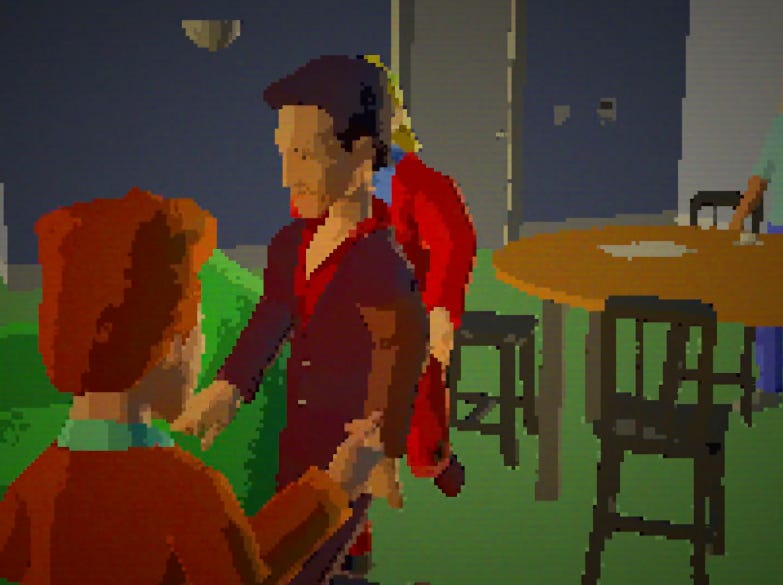1. Existentialism at the grocery store
What characterizes the aesthetic experience of gen AI media?
It appears I've missed the peak of Nothing, Forever, the 24/7/365 Twitch stream of what people dubbed "AI Seinfeld," a procedurally generated animated sitcom by Mismatch Media. A study of Larry David's '90s original, it's since been relaunched following a two-week ban due to an offensive remark from its lead; now its core cast of parodied characters have been swapped out for loose substitutes. Sometimes I put it to the side of my desktop, neatly arranged as some ambient background noise.
I've tried watching it straight, which is a somewhat disjointed viewing experience that requires especial effort: there's the obvious appeal to my Zoomer brain in the voxel graphics, crude and full of memetic potential — while presumably a stylistic choice, they remain jankily charming. People clipping in and out, walking into furniture and convening at the in-universe diner stiffly, zombielike. Occasional jarring canned laughter that erupts, adding to this dreary atmosphere of a sunsetting minifranchise.
The recent glitch in which characters would face off a fridge for hours on end earned the stream some attention again; people rushed to memorialize the Nothing, Forever of better days across the chat and the stream's Discord server. Sifting through what remains of the experiment, there's a recognition that contemporary media consumers are perhaps predisposed to historicizing. (This we know: that social media platforms have made many of us expert archivists of selves; several of us head into experiences with their presentation online in mind.) And it feels as though the show (if we can call it one) itself riffs on this. Manfred Fredman (née Fred Kastopolous) and Kelly Coffee (née Yvonne Torres) and crew walk in place as they engage in ever-existentialist conversation:
... What did the wind taste like?
It tasted like time lost, like solitude under a fading sun
I can't help but wonder if the creators have turned the metacommentary up to the max... we love a break in the fourth wall but it seems to be the main mechanism of Nothing, Forever in its final(?) heaving gasps. What is the temperature of near completely AI-generated media? Does it desire an audience the way human-made media does?
Partaking in the collective mourning of this show, I also can't resist screen recording it in the hopes of catching some especially haunting dialogue. The fact that it's released on Twitch, a platform so familiar, feels surreal: how much compute does it require? Have we truly already grown so accustomed to AI-generated media that a neverending livestream is already a banal footnote in the history of this technology?
(I tried to make sense of the sheer energy and resources it takes to run this and consulted the AI Now Institute's article on computational power and AI... and then realized that I was worrying about the gen AI equivalent of a carbon footprint. Looking online and consulting LLM powered chatbots, I asked how much would it take to keep such a piece of media up and running and was reassured that this was a cheap operation in USD.)I'll open the chatroom now and again in the hopes of a few more random comments from other anonymous viewers, which brings me to the question of memory: Nothing, Forever feels like an abandoned mall, this melancholic, romantic icon of an America from just a few decades ago. What is memory in our current age of data proliferation and endless creation? The inevitability of the next frame, the next laugh track, the next self-aware question in Nothing, Forever has me wondering whether time has weight and value in this medium.
An hour or two with the stream (and intermittent ads), I begin to fully appreciate the nothingness of Nothing, Forever. I come to understand that the choice of the sitcom reflects a certain comfort and complacency, and that upon watching this for any prolonged portion of time, the limits of human perception (, attention, boredom) force you to interpret this in some personally significant way.
Since there is no tangible, theatrical way for me to understand the material effort that this media has demanded, I turn my mind to the quality of the graphics, specifically, their low resolution when the polish and detail of generative imagery feel like a visceral way to compensate for the lack of apparent human presence throughout the diffusion process. I think of our protests that human creativity has merit, that our creativity(now what does that really mean?) is our saving grace. Is it really so?
(I promise I am not a misanthrope)Earlier I'd made a kind of wild(?) claim that using AI in such a way enables us to eroticize waste: analogies of the preciousness of tactile media fall apart when a prompt yields variations of an idea. Does a new material relationship with media (and with our ideas) emerge when we work with/in multiples? Does gen AI share the sensual qualities of plastic, in which we enclose products for the fierce twenty-first century consumer? I still stubbornly refuse to believe in using AI just for the sake of AI...
A few weeks ago I fortunately learned of James Welling's Thought Objects. Standing in the gallery reminiscent of a neuomorphic sensibility, I found myself enthralled with the illusions of space and texture. After a while I gave up trying to discern how the artist's unseen digital manipulations altered the photography and tried imagining the gesture of it all. (Something about photography being a familiar enough medium, perhaps?) I wonder when will I feel the same about gen AI media.


